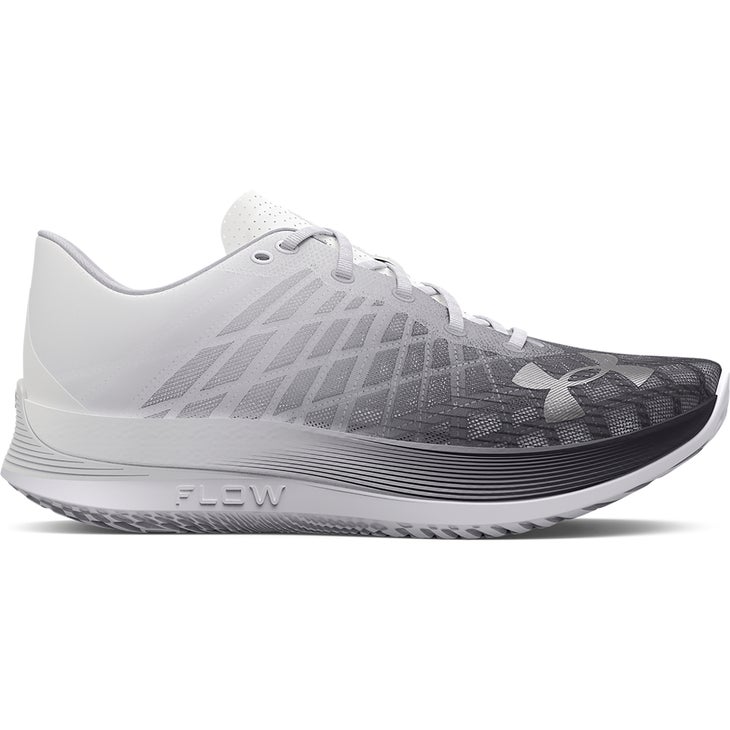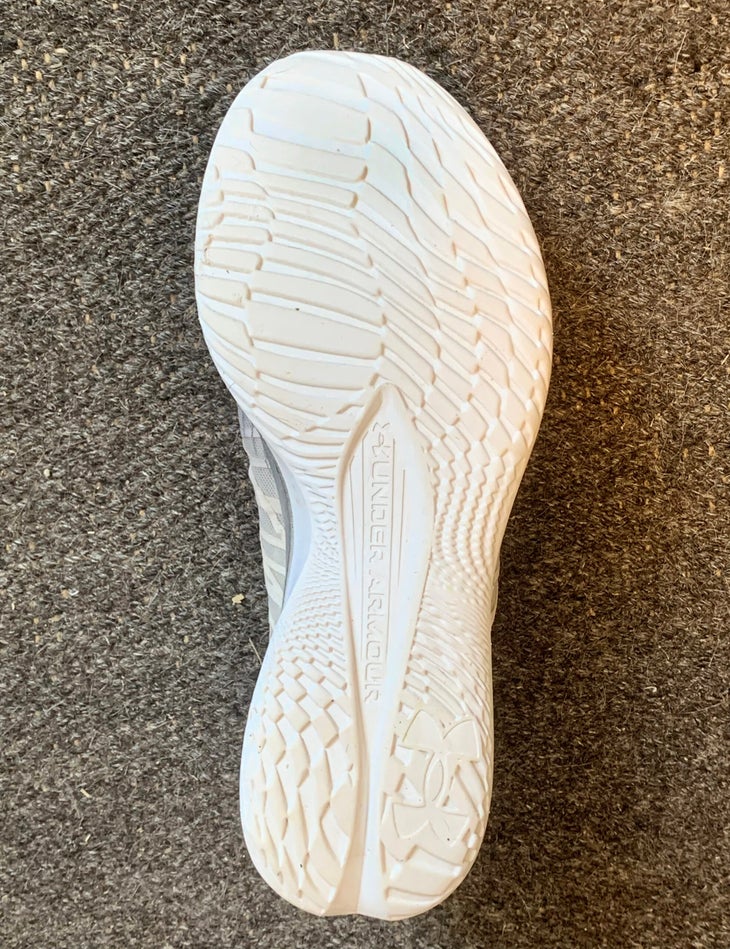Products You May Like
Get access to everything we publish when you
sign up for Outside+.
Under Armour Flow Velociti Elite Review
- MSRP: $250
Weight: 7.5 ounces (Unisex)
Stack Height: 36-millimeter heel / 28-millimeter forefoot (8-millimeter drop)
If you show up as late to a party as Under Armour has to the supershoe lovefest going on in the running shoe world, you better bring something unique. It’s been five years since Nike started the supershoe shuffle with the Vaporfly 4%, and by now, every major brand and several minor ones have staked their corner on the dance floor. Many are on their second or third supershoe versions. To Under Armour’s credit, it didn’t just reverse-engineer other’s innovations and create a carbon-plated clone. The Flow Velociti Elite leverages technologies the brand has been refining on other shoes in their line, and capitalizes on what the apparel company has long done best: creating a comfortable fit.
After spending two weeks with the new Flow Velociti Elite, including several speed workouts at a variety of paces, I can report that they fill a unique niche in the supershoe spectrum. I plan to continue wearing them for up-tempo training and racing due to their unparalleled comfort, accommodating fit, and smooth, speedy ride.
RELATED: Racing Shoes: What You Need To Know
The Tech
Like other supershoes, the Flow Velociti Elite has a curved carbon-fiber plate sandwiched between layers of highly-responsive midsole foam. What distinguishes each shoe’s ride is the type and thickness of the foam, the shape of the toe rocker, and the rigidity of the plate.
For their midsole foam, Under Armour chose two different materials: on top is a soft, bouncy layer of Pebax foam, widely acknowledged as the industry standard for lightweight cushioning and energy return. On the bottom, however, the Flow Velociti Elite has a slab of the brand’s proprietary “Supercritical Flow” foam, a lighter, bouncier, nitrogen-infused version of the Olefin-based material they’ve used on past Flow models. Here, as on previous Flow shoes, this foam serves as both midsole and outsole.

Doug Smiley, Under Armour’s global director of competitive running footwear, says the decision to incorporate a layer of Flow foam rather than use a full-Pebax midsole stemmed from the advantages of eliminating the outsole. “Flow delivers ground feel and amazing traction without the added extra weight of rubber,” Smiley says. “Once you get into outsoles, you’re adding a lot of glues, a lot of adhesives, variabilities in manufacturing processes—Flow is super consistent.” One other advantage: Given that the whole height of the Flow foam provides cushioning, the Velociti Elite’s 36-millimeter stack height provides similar cushioning as a 38-millimeter stack that includes two millimeters of firm rubber—without pushing you farther away from the ground.
Smiley touts the lack of an outsole as also improving the shoe’s durability, which seems counterintuitive but makes sense when he explains how the Flow foam continues to resist wear through its entire thickness, while other supershoes show quick and dramatic degradation as soon as the thin outsole pads are breached, or wherever the midsole foam is exposed to road friction. I haven’t run in them long enough to see any wear, but can confirm the foam’s exceptional traction and smooth feel on ground contact.
I found that the two midsole materials delivered a nicely balanced ride, providing soft cushioning directly underfoot, and a stable and springy platform beneath. The midsole is shaped into a long, gradual rocker that starts under the ball of the foot and creates a comfortable roll off the toe, one that is far less aggressive than the sharp drop-off found in many competitors’ models. “We were going for that smooth rocker feel,” says Smiley. “But also having a plate that gives you extra kick and pop.”
The plate, while fully carbon fiber, is more flexible than plates in other supershoes, bending as easily as the composite-material plates in many semi-supershoes. It performs much like the one-directional-flexing Carbitex plates in the Altra Vanish Carbon and Saucony Endorphin Edge. The Under Armour plate let my toes flex upward, but it made its presence known as I rolled off the toe, creating a long lever for powerful push-offs.
Smiley says all these design elements were part of a strategy to make the shoe accessible as well as high-performing: “We wanted to have it smooth and natural, and an easy transition from where we were with other products. It’s a different experience, but it doesn’t feel totally foreign.”
The Fit
Even more impressive than the Flow Velociti Elite’s smooth, grounded ride, is its comfort and fit. Unlike many supershoes, the upper doesn’t feel pared down to the bare minimum: one layer of stiff and scratchy fabric with exposed seams. Under Armour’s molded heel cup is relatively thin, but smoothly finished and strategically padded, as is the tongue. Forward of the heel, a transparent, flexible mono-mesh upper is wrapped with thin, criss-crossing tape lines—stitched, not glued—to hold the foot securely while allowing it to move and flex through the stride.

What contributes most to the shoe’s comfort, however, is the shape. While the heel is racing-shoe snug and narrow, the sole widens dramatically at the ball of the foot, particularly on the big-toe side. It is as wide or wider in the forefoot than all the other supershoes released this year—even Altra’s—yet the dialed-in upper ensures it doesn’t feel sloppy. “We wanted to make sure the runner’s foot is completely centered, engaged on the platform for maximum propulsion going forward,” says Smiley. The result is not only a roomy, comfortable feel but also a stable, connected stance.
Bottom Line
The Flow Velociti Elite sits in the space between high-stacked, aggressively-rockered, rigid-plated marathon supershoes and flexible-plated or plateless light-and-fast training shoes. It delivers a familiar, accessible ride with some extra pop. Smiley says, “Every runner should be able to engage the shoe and have a better experience.”
This shoe works well for runners making the transition to a plated shoe, or those who don’t appreciate the unstable hyper-bounciness and prescriptive roll of most supershoes. It’s also a good choice for anyone looking for a fast shoe that has a wide, stable, anatomically-shaped forefoot.
I was a fan of the fit from step-in, and found the ride comfortable at any pace, even when tired and heel-striking. While I didn’t experience quite the lift-off that other supershoes provide at high speeds, I did feel connected and quick when picking up the tempo, and I wasn’t forced into an unnatural, unsustainable gait. I won’t run in them every day, as that’s not recommended for any plated shoe. But I’ll be wearing them for speed workouts, tempo runs, and in an upcoming 5K.
Under Armour offered a limited-availability launch of the Flow Velociti Elite in June 2022, but you’ll now more than likely have to wait for the full-scale global launch in spring 2023 to get a pair.
Similar Shoes
Altra Vanish Carbon, On CloudBoom Echo, Puma FAST-R Elite, Saucony Endorphin Speed 3
